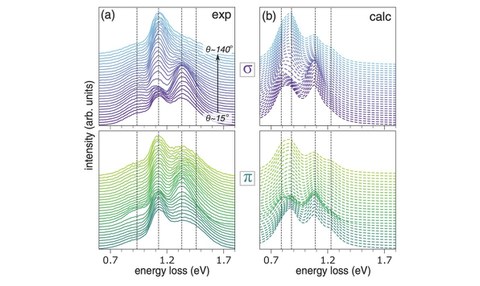29.04.2021
Forschung: Orbitalphysik in dem kanonischen Orbitalsystem KCuF3

Winkelabhängigkeit der Orbitalanregungen σ-(violett) und π-polarisierter (grün) einfallender Röntgenstrahlung. Die vertikalen gestrichelten Linien stellen die gemittelten Spitzenwerte der angepassten dd-Anregungen dar. (b) Berechnete winkelabhängige Spektren. Die vertikalen gestrichelten Linien zeigen die berechneten Werte der dd-Anregungen.
Periodische Anordnungen von Ladungs-, Spin- und Orbitalfreiheitsgraden sind charakteristisch für Übergangsmetalloxide. Diese geordneten, symmetriegebrochenen Zustände stehen oft im Zusammenhang mit physikalischen Eigenschaften wie der Hochtemperatur-Supraleitung und dem kollossalen Magnetwiderstand. Ähnlich wie die kollektive Spinwelle in antiferromagnetisch geordneten Heisenberg-Systemen ist die kollektive Orbitalwelle, das Orbiton, das Kennzeichen der Orbitalordnung. Orbitonen in realen orbital geordneten Systemen sind bisher kaum studiert. Wir berichten über die Untersuchung von Spin- und Orbitalanregungen in dem Material KCuF3, einem kanonischen Orbitalordnungssystem, unter Verwendung der impulsabhängigen resonanten inelastischen Röntgenstreuung (RIXS) und eröffnen damit einen neuen Weg für die Forschung der Orbitalphysik.
J. Li, L. Xu, M. Garcia-Fernandez, A. Nag, H. C. Robarts, A. C. Walters, X. Liu, J. Zhou, K. Wohlfeld, J. van den Brink, H. Ding, K.-J. Zhou
Unraveling the Orbital Physics in a Canonical Orbital System KCuF3,
Phys. Rev. Lett. 126, 106401(2021) (arXiv)
